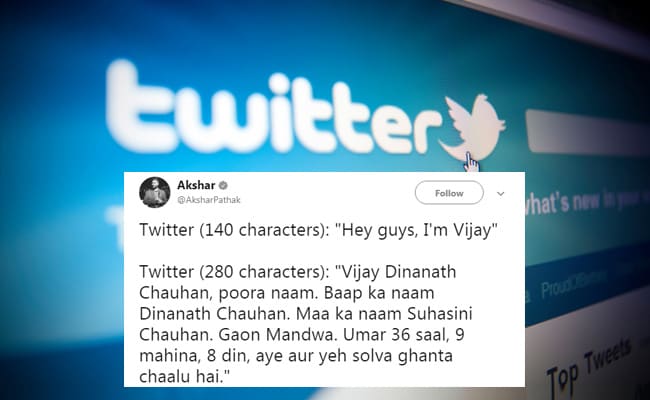
Twitter has announced a test project increasing the character limit to 280.
Here are the funniest reactions to Twitter’s new 280 characters limit:
Lots of desi memes made their way to Twitter

Twitter has announced a test project increasing the character limit to 280.
Here are the funniest reactions to Twitter’s new 280 characters limit:
Lots of desi memes made their way to Twitter
Twitter chief executive Jack Dorsey last year made a definitive announcement about the company’s famous 140-character count amid rumors that the firm would substantially relax the limit. “It’s staying,” Dorsey told the “Today” show’s Matt Lauer. “It’s a good constraint for us.”
On Tuesday, the company took it back – for some people, at least.
Starting Tuesday, Twitter said, it’s testing a feature to let some users double the amount of characters allowed in a tweet. The 280-character limit will only be available to a small group of people on the site. When asked for more information, Twitter said it would be a “single-digit percentage” of its 328 million users – so, millions – who will be “randomly chosen.”
The company declined to comment directly on how it’s choosing those people or why it changed its mind about sticking to its 140-character limit. But in a company blog post, product manager Aliza Rosen and senior software engineer Ikuhiro Ihara said the team started looking into the restrictions of the 140-character limit after noticing differences among languages.
Some languages – specifically Chinese, Japanese and Korean – allow for greater expression in fewer characters, Rosen and Ihara said.
“We see that a small percent of tweets sent in Japanese have 140 characters (only 0.4%). But in English, a much higher percentage of tweets have 140 characters (9%). Most Japanese tweets are 15 characters while most English tweets are 34,” the post said.
The 280-character test will roll out in all languages except for Chinese, Japanese and Korean.
It’s true that some languages allow each character to count for more. My own last name, Tsukayama, is nine letters in English; phonetically in Japanese, it’s four letters. If you use Japanese kanji characters, it’s three.
But Twitter users in other languages have found workarounds to bypass the 140-character limit. It’s common to see someone send out a thread, or “Twitterstorm,” by signaling that their thoughts are going to come in several bite-sized chunks – i.e., typing 1/6 to note the first installment of six related tweets. Twitter itself did this Tuesday morning, when addressing why it hasn’t suspended President Donald Trump from its platform.
Dorsey himself has used a common workaround – posting an image of longer text – to get around the character limit, even while extolling the virtues of brevity early last year.
It’s surprising that Twitter would revisit such an integral part of its network, especially after definitively stating the 140-character limit would remain. And, judging by the post, the company clearly expects some backlash (perhaps after seeing the reaction to the rumors Dorsey felt compelled to address on the “Today” show).
“Although we feel confident about our data and the positive impact this change will have, we want to try it out with a small group of people before we make a decision to launch to everyone,” the blog post said. “We understand since many of you have been tweeting for years, there may be an emotional attachment to 140 characters – we felt it, too. But we tried this, saw the power of what it will do, and fell in love with this new, still brief, constraint.”
Despite the big announcement, Twitter is being pretty quiet about how this will look to the everyday Twitter user – how likely they are to see the feature on their own accounts, the accounts of others in their timeline, or perhaps in the hands of a certain tweeter-in-chief.
But one thing that’s telling: Rosen and Ihara said that “in all markets, when people don’t have to cram their thoughts into 140 characters and actually have some to spare, we see more people tweeting – which is awesome!”
In other words, Twitter has found that removing this pain point – even if it means giving up something that’s been core to its identity – can help it reach more people who will then use its product more. And, ultimately, that’s what Twitter has been seeking for years: a way to gain more users and to make its quirky ways easier to understand.
Year by year, the social networking site has made changes to improve its usability, including tweaking the way timelines work, as well as modifying its rules to prevent images, videos and GIFs from counting against the number of characters in a tweet. Not all of those changes have been welcomed by its most devoted users; Twitter has also reversed policy due to user complaints. With this test, Twitter is evolving once more in its pursuit of new users. It’s the company’s biggest step away from its past yet.
[“Source-gadgets.ndtv”]
